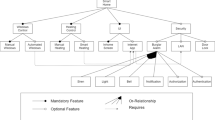Abstract
There is a growing need to reduce the cycle of business information systems development and make it independent of underlying technologies. Model-driven synthesis of software offers solutions to these problems. This article describes a method for synthesizing business software implementations from technology independent business models. The synthesis of business software implementation performed in two steps, is based on establishing a common feature space for problem and solution domains. In the first step, a solution domain and a software architecture style are selected by matching the explicitly required features of a given software system, and implicitly required features of a given problem domain to the features provided by the solution domain and the architectural style. In the second step, all the elements of a given business analysis model are transformed into elements or configurations in the selected solution domain according to the selected architectural style, by matching their required features to the features provided by the elements and configurations of the selected solution domain. In both steps it is possible to define cost functions for selecting between different alternatives which provide the same features. The differences of our method are the separate step of solution domain analysis during the software process, which produces the feature model of the solution domain, and usage of common feature space to select the solution domain, the architectural style and specific implementations.
Access this chapter
Tax calculation will be finalised at checkout
Purchases are for personal use only
Preview
Unable to display preview. Download preview PDF.
Similar content being viewed by others
References
Abbott, B., Bapty, T., Biegl, C., Karsai, G., Sztipanovits, J., 1993, Model-Based Software Synthesis, IEEE Software, May, 10(3), 1993, pp.42–52.
Bass, L., Clements, P. and Kazman, R., 1998, Software Architecture in Practice, Addison-Wesley.
Batory, D. and O’Malley, S., 1992, The design and implementation of hierarchical software systems with reusable components, ACM Transactions on Software Engineering and Methodology, Vol. 1, No. 4, pp. 355–398.
Czarnecki, K., Eisenecker, U., W., 2000, Generative Programming, Methods, Tools, and Applications, Addison-Wesley.
Honeywell, 1996, Domain-Specific Software Architectures, www.htc.Honeywell.com/projects/dssa
Kang, K. C., Cohen, S. G., Hess, J. A., Novak, W. E., Peterson, A. S., 1990, Feature-Oriented Domain Analysis (FODA) Feasibility Study, SEI CMU, CMU/SEI-90-TR-021
Kang, K. C., Kim, S., Lee, J., Kim, K., Shin, E., and Huh., M., 1998, FORM: A feature-oriented reuse method with domain-specific reference architectures. Annals of Software Engineering, Vol. 5, pp. 143–168.
Medvidovic, N., Taylor, R. N., 1997, A Framework for Classifying and Comparing Architecture Description Languages, Proceedings of the Sixth European Software Engineering Conference (ESEC/FSE 97), Ed. by M. Jazayeri and H. Schauer, Springer Verlag, pp. 60–76.
Mellor, S. J., 1995, Reuse through automation: Model-Based Development, Object Magazine, September 1995.
OMG, 2001a, Model Driven Architecture, OMG 01-07-01, ftp.omg.org/pub/docs/ormsc
OMG, 2001b, OMG Unified Modeling Language Specification Version 1.4, OMG 01-09-67, ftp.omg.org/pub/docs/formal
Peterson, A. S., Stanley, J. L., 1994, Mapping a Domain Model and Architecture to a Generic Design, SEI CMU, CMU/SEI-94-TR-008
Raabe, A., 2002, Techniques of combination of metamodel extensions, Proceedings of the Estonian Academy of Sciences, Engineering, 8(1), 2002, pp. 3–17.
Raabe, A., 2003, Software Engineering Environment for Business Information Systems, In Proceedings of ICEIS 2003, 5th International Conference on Enterprise Information Systems, Angers, France, 23–26 April, 2003, Volume 3, pp. 129–137.
Rumbaugh, J., Jacobson, I., and Booch, G., 1999, The Unified Modeling Language Reference Manual, Addison-Wesley, Reading, Massachusetts.
SEI, 2002, Domain Engineering: A Model-Based Approach, www.sei.cmu.edu/domain-engineering
Simos, M., Creps, D., Klinger, C., Levine, L., and Allemang, D., 1996, Organization Domain Modeling (ODM) Guidebook, Version 2.0, Technical Report for STARS, STARS-VC-A025/001/00, June 14, 1996.
Singh, I., Stearns, B., Johnson, M. and the Enterprise Team, 2002, Designing Enterprise Applications with the J2EE Platform, Second Edition, Addison-Wesley.
Shaw, M., Garlan, D., 1996, Software Architecture: Perspectives on an Emerging Discipline, Prentice-Hall.
Weiss, D., 1996, Family-Oriented Abstraction, Specification, and Translation The FAST Process, Keynote talk at Computer Assurance Conference (COMPASS), 19 June 1996, www.research.avayalabs.com/user/weiss/pubs/compas s96.ps
Author information
Authors and Affiliations
Editor information
Editors and Affiliations
Rights and permissions
Copyright information
© 2006 Springer
About this paper
Cite this paper
Raabe, A. (2006). Feature Matching in Model-Based Software Engineering. In: Seruca, I., Cordeiro, J., Hammoudi, S., Filipe, J. (eds) Enterprise Information Systems VI. Springer, Dordrecht. https://doi.org/10.1007/1-4020-3675-2_23
Download citation
DOI: https://doi.org/10.1007/1-4020-3675-2_23
Publisher Name: Springer, Dordrecht
Print ISBN: 978-1-4020-3674-3
Online ISBN: 978-1-4020-3675-0
eBook Packages: Computer ScienceComputer Science (R0)




